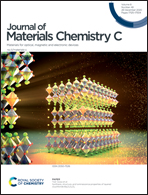Achieving crystal-induced room temperature phosphorescence and reversible photochromic properties by strong intermolecular interactions†
Abstract
Although a lot of organic materials with changes of appearance and fluorescence colors in the solid state have been developed, organic materials with solid-state phosphorescence and photochromic properties have been rarely reported. In this study, three novel D–A-type pyranone–carbazole compounds CzPy, DCzPy, and CzPyBr were designed and synthesized. All these compounds in the crystalline state emit orange-yellow phosphorescence with a lifetime of 43–764 ms. Single crystal structural analyses and theoretical calculations reveal that the intermolecular interactions play two major roles: (1) enhancing the spin–orbit coupling and shortening the energy gap between singlet and triplet states to promote intersystem crossing of excitons; (2) stabilizing triplet excitons to improve the radiation ability of energy. Additionally, crystalline CzPyBr and amorphous DCzPy exhibit obvious rapid photochromic properties from white to dark red, for which the intermolecular interaction of compounds in different morphologies may be the main factor in the photochromic process. The photochromic process shows excellent and rare performances of fast response, high contrast, good reversibility, fatigue resistance, and strong stability in high temperature, oxygen, and water. Furthermore, the DCzPy/benzophenone doping material can be constructed using cheap and easily available benzophenone as the host and DCzPy as the guest, which also shows excellent photochromic performance and can be more practically applied to anti-counterfeiting encryption of information due to lower cost and lower toxicity.



 Please wait while we load your content...
Please wait while we load your content...